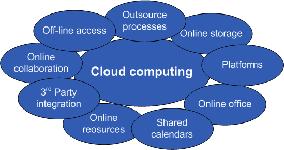 |
 |
Automation Cloud Computing Futures
By : Jim Pinto, Cloud computing is one of the hottest technology fields today. In manufacturing, clear targets for cloud computing include manufacturing execution systems and production planning systems. As the technology matures, cloud computing will become more widespread in manufacturing and automation suppliers will track the demands.
October 2013
|
 Cloud computing is one of the hottest technology fields today. In manufacturing, clear targets for cloud computing include IT-related applications such as manufacturing execution systems (MES) and production planning systems (PPS).
Cloud computing is one of the hottest technology fields today. In manufacturing, clear targets for cloud computing include IT-related applications such as manufacturing execution systems (MES) and production planning systems (PPS).
The market is projected to soar from $40.7 billion in 2011 to $241 billion in 2020, according to Forrester Research. In manufacturing, clear targets for cloud computing include IT-related applications such as manufacturing execution systems (MES) and production planning systems (PPS). Control rooms have limited space - particularly those located in older plants or in offshore facilities. Having cloud servers to run multiple applications such as HMIs and engineering workstations has many advantages beyond just space saving. Collection and analysis of data for historians, plus preventive and predictive maintenance data, can be consolidated with larger multi-location services, particularly in multinational companies. Having these located in cloud infrastructure make sense because each individual plant can upload data to the cloud, reducing dependency on corporate networks. For automation product and system suppliers, significant gains in efficiency, cost and capability can be achieved as products become more intelligent and connected through the cloud. The key transition point is the movement from an isolated world into the completely connected enterprise, providing vastly increased productivity. There are several new demands with distributed cloud architectures. Data is no longer strictly local; it needs to be readily available and its quality impacts the whole process. Services need to scale from discrete to intelligent distributed systems that allow cost optimization through workload consolidation. It is highly beneficial for automation suppliers to think not in terms of discrete boxes, but complete services. Proprietary architectures must be eliminated and integration of cloud services simplified by using open communications standards. Industrial control applications rely strongly on real-time data, and it is unlikely that cloud computing will be used for real-time control any time soon. However, control manufacturers will most likely follow the lead of other similar businesses and use the cloud for tasks that support manufacturing, particularly data storage and remote access. Two-way access to automation controllers won't be provided, though this too is changing as system integrators start to work with OEMs to design cloud-based access and control systems with automated two-way communications. In some applications, the cloud will become part of the critical path for the end user. SecurityThough data stored in the cloud could be protected by strict security measures, storing data outside the plant does create new types of vulnerabilities; it's risky to send proprietary data into the cloud where competitors may have access. Cloud providers will be required to have much stronger security and encryption than typical in-house IT departments, and ensure compliance with regulations about where certain data can be stored and who can access the data.The collective data in the cloud is much more extensive and valuable than the data in any single industrial company, which makes it a more attractive target to hackers. Configuration or software errors could accidentally allow access to organizational data and resources to other subscribers. Attackers could also pose as subscribers to gain unauthorized access and exploit vulnerabilities. Having to share an infrastructure with unknown outside parties can be a major drawback for some applications; it demands a high level of assurance of the strength of the security mechanisms used by the cloud provider. A business-focused risk-management approach is demanded to strike the right balance between protecting data and taking advantage of more efficient and flexible technology environments. By 2020, cloud computing will look radically different. Computing will become invisible; software will be modular and divorced from hardware; low-power, low-cost commodity hardware will be standard, including storage, servers and switches with low-cost, high-speed information connects. My August column discussed how IT responsibility is shifting away from centralized departments. A new generation of CIOs will emerge as cloud computing demands more manufacturing and automation specialists. As the technology matures, it's a good bet that cloud computing will become more widespread in manufacturing, with end users pursuing cost and productivity improvements, and automation suppliers tracking those demands. 
|
 Pinto's Points How to win in the Automation Business Go shopping - books, electronics, CD/DVD Selected advertising coming here. Contact Jim Pinto for rates. |
Return to Index of all JimPinto Writings

 Return to JimPinto.com HomePage
Return to JimPinto.com HomePage
If you have ideas or suggestions to improve this site, contact: webmaster@jimpinto.com
Copyright 2006 : Jim Pinto, San Diego, CA, USA
